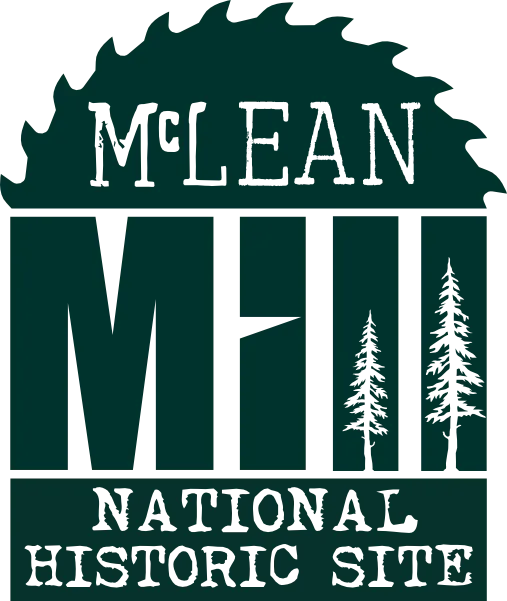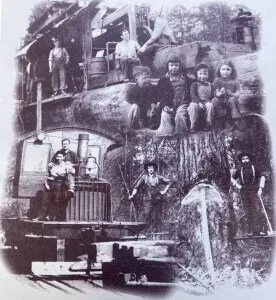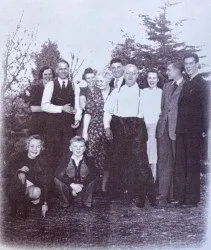The Mill
The McLean Mill National Historic Site is located on 12.8 hectares and contains 35 buildings and structures.
McLean Mill
The McLean Mill National Historic Site was acquired by the City of Port Alberni in 1988 through donations from the McLean family and MacMillan Bloedel (now Weyerhaeuser).
With the assistance of funding from Parks Canada and Forest Renewal B.C., the sawmill has been restored to a fully working condition, the mill pond and the dam have been reconstructed and some of the residences and service buildings have been preserved.
Even before the acquisition of the site by the city, the Western Vancouver Industrial Heritage Society initiated a number of projects to restore the historic McLean machinery. The Society continues to play a key role in the operation of the site such as logging shows or steam equipment demonstration.
The McLean Mill National Historic Site is located on 12.8 hectares and contains 35 buildings and structures. They form a self-contained community of residences, offices and service buildings centred around the steam-driven sawmill and mill pond. The R.B. McLean Lumber Company was a family-run business that operated from 1926 to 1965. Although small in scale, its logging, milling and marketing operations were similar to larger mills in the province. Much of its original machinery and buildings have survived, making it a rare example of a sawmill complex from the first half of the 20th century. For these reasons the McLean Mill was designated as a national historic site in 1989.
We invite you to explore the site and discover for yourself the fascinating relics of a bygone age – visit just a part or tour the whole site. The map provides information about the five main themes of the site: Forest, Camp Life, Logging, Sawmilling, and Markets and Transportation.
THE FOREST
The path leading from the visitor centre to the historic area goes through second growth forest that was originally logged by the McLeans in the 1920s. None of the new forest was planted. Regeneration occurred naturally. Fir and Cedar trees can be seen growing out of rotting stumps. Some of the old stumps have notches that held the springboards on which the fallers stood as they whipped their hand saws back and forth.
CAMP LIFE
Along the main road running through the site is a group of buildings used by the people who lived on the site. Looking down the road toward the pond, you will see a row of three buildings: the office, R.B. McLean house and the cookhouse. Immediately behind you is the Arnold McLean House and off to the right is a worker’s house.
The former teacherage, later a yard office, is off to the left. If you walk down the road you will see the root house across from the cookhouse. To the right of the road down by the creek are the blacksmith shop, on the left, and the bunkhouse. Except for the R.B. McLean house, that has been rebuilt as a modern facility and contains public washrooms, the other buildings have been partially restored. Small exhibits inside many of these buildings tell of their history and of the people who lived there.
LOGGING
As you cross the dam along the pond, you will see a log A-frame that is used like a crane to onload logs from trucks into the pond. Across the pond from the mill are buildings once used to service machinery of the McLean logging operation. Restored logging trucks from the 1930s or 1940s can sometimes be found in the garage or elsewhere on the site. Beyond the garage is the original McLean steam donkey engine that was used throughout the company’s history. It was used to yard the logs to the landing and power the boom that loaded the logs on to rail cars or trucks. It has been restored by the Western Vancouver Island Heritage Society and is the central piece in the logging interpretive area. Across from the garage is a machine shop, used in the 1950s and 1960s for repairing equipment for both the mill and logging operations.
SAWMILLING
The steam-operated sawmill is the focal point of the site. The entrance into the mill is from the far (pond) side. A turn to the left at the entrance takes you under the mill to view some of the steam-powered machinery that ran the equipment above. Best to do this before touring upstairs because the mill tour exits at the other end. The main steam engine was built by Wheland Machine Works about 1890. It powers the head saws by means of an overhead drive shaft, and is used to power the belts and drives that ran the other machinery. At the front of the mill is a steam tractor whose engine used to power the planer from 1946 to 1956 when it was located on the floor above. At the back side under the mill is perhaps the oldest piece of equipment on the site.
Built in the 1880s, this steam engine was originally used to power a ship’s winch. It was acquired by the McLeans to power the log carriage before the carriage was converted to electricity in 1958. The carriage was changed back to its earlier form as part of the mill restoration.
Back on the main path, stairs lead up to a viewing gallery running along the far side of the mill that allows safe viewing of the various processes even when the mill is operating. There is an elevator for those unable to climb the stairs. You should start at the pond side to see the logs coming up from the pond, and being rolled onto the carriage from the log deck. The head saws slabbed the logos into timbers. The gallery goes around a little room sticking out of the side of the mill. This was used for filling the saws. The head rig, containing a 50 inch and a 54 inch circular saw, is located on the other side of this room. If you proceed down the deck from the head rig, you will see the transfer chains for moving the log slabs onto the belts that feed the edger that makes timbers into boards. Further down is the trim saw for cutting timber and lumber to length. And at the far end is the planer.
MARKETS & TRANSPORTATION
Selling lumber was the whole purpose of the R.B. McLean business. The area west of the mill is where the lumber was stacked by type to dry and to await shipment to market. Lumber was moved around the yard by lumber carriers. The Dip Tank is where lumber was loaded on to rail cars from the loading deck after being dipped in a chemical bath to inhibit mould that discoloured the wood. Lumber was also shipped out by truck. The rail cars were pulled out to the main line by a small locomotive. Built by Westminster Iron Works in 1928 for the R.B. McLean Co., it had a small gasoline engine made by the Buda Manufacturing Co. When it arrived at the site, it was given the nickname “The Buda” and it has been called that ever since.
Photo Gallery of the Mill
Contact Us
Do you have any questions about McLean Mill?
Drop us a line, we will do our best to answer your question.




